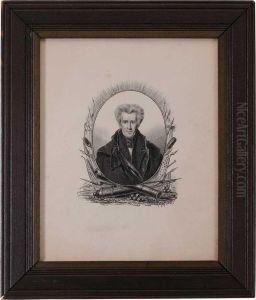Albert Newsam Paintings
Albert Newsam was an American lithographer and one of the most prominent and skilled deaf artists of the 19th century. Born in Steubenville, Ohio, on May 20, 1809, he was deaf and possibly mute from birth. Despite the challenges he faced due to his disabilities, Newsam had a significant impact on American lithography and is remembered for his portraits and artistic contributions.
Newsam apprenticed under the artist-publisher Cephas G. Childs in Philadelphia, who recognized his talent early on. Childs was associated with the lithographic firm Childs & Inman, and it was here that Newsam honed his skills in the art of lithography. After Childs & Inman dissolved, Newsam worked with the successor firm, which eventually became P.S. Duval & Co., one of the leading lithographic establishments in the United States.
During his career, Newsam became known for his ability to capture likenesses and translate them into lithographic portraits. He created thousands of portraits, including those of notable figures such as presidents, politicians, and celebrities of the time. His work was characterized by a keen attention to detail and a sensitive approach to his subjects. In addition to portraits, Newsam also worked on certificates, views, and other illustrations, contributing widely to the popular visual culture of his era.
Newsam's legacy is not only in the volume and quality of his work but also in his ability to overcome the barriers he faced as a deaf artist in the 19th century. He remained with P.S. Duval & Co. for much of his career, where he was highly regarded for his artistic abilities. Sadly, towards the end of his life, Newsam's eyesight began to deteriorate, affecting his ability to work. He passed away on November 20, 1864, in Philadelphia, leaving behind a body of work that continues to be appreciated for its historical value and artistic quality.
